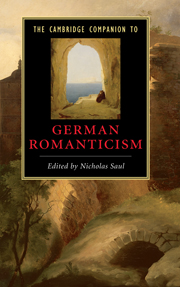Book contents
- Frontmatter
- 1 What is Romanticism, and where did it come from?
- 2 From early to late Romanticism
- 3 Prose fiction of the German Romantics
- 4 The Romantic lyric
- 5 The Romantic drama
- 6 Forms and objectives of Romantic criticism
- 7 Romanticism and Classicism
- 8 Women writers and Romanticism
- 9 The Romantics and other cultures
- 10 Love, death and Liebestod in German Romanticism
- 11 Romantic philosophy and religion
- 12 Romantic politics and society
- 13 Romantic science and psychology
- 14 German Romantic painters
- 15 Romanticism and music
- 16 Transformations of German Romanticism 1830-2000
- Key authors and their works
- Further reading
- Index
7 - Romanticism and Classicism
Published online by Cambridge University Press: 28 September 2010
- Frontmatter
- 1 What is Romanticism, and where did it come from?
- 2 From early to late Romanticism
- 3 Prose fiction of the German Romantics
- 4 The Romantic lyric
- 5 The Romantic drama
- 6 Forms and objectives of Romantic criticism
- 7 Romanticism and Classicism
- 8 Women writers and Romanticism
- 9 The Romantics and other cultures
- 10 Love, death and Liebestod in German Romanticism
- 11 Romantic philosophy and religion
- 12 Romantic politics and society
- 13 Romantic science and psychology
- 14 German Romantic painters
- 15 Romanticism and music
- 16 Transformations of German Romanticism 1830-2000
- Key authors and their works
- Further reading
- Index
Summary
Broadly conceived, European Romanticism designates a period of 100 years extending from Rousseau to Baudelaire, and in painting and music it follows Classicism. German literary history not only uses the term more narrowly, as this volume demonstrates, but it also distinguishes between contemporaneous movements called Romanticism and Classicism. In the context of European comparative scholarship Johann Wolfgang Goethe (1749-1832) and Friedrich Schiller (1759-1805) are Germany's greatest Romantics, but for German scholars they embody the movement called German or Weimar Classicism, which is cast variably as the enemy, diametric opposite, or complement of Romanticism. Scholars today no longer universally accept the distinction between Romanticism and Classicism, nor do they even argue much whether it should be drawn, since proponents of both sides consider the question settled. A frequent compromise has been to speak of a Goethezeit (Age of Goethe), which can then be divided into Classicism and Romanticism or not as one chooses. This essay describes the historical details of the connections between the groups, their intellectual commonalities and differences and what might properly be called Goethe's role in German Romanticism; then it considers briefly the history and function of the distinction. As the canon of German literary history crystallised in the late nineteenth century, Classicism often included in addition to Goethe, Schiller and Wilhelm von Humboldt (1767-1835) the older dramatist and theorist Gotthold Ephraim Lessing (1729-81) and the poet Christoph Martin Wieland (1733-1813), tutor to the Duke of Weimar and Goethe's respected associate.
- Type
- Chapter
- Information
- The Cambridge Companion to German Romanticism , pp. 119 - 132Publisher: Cambridge University PressPrint publication year: 2009



